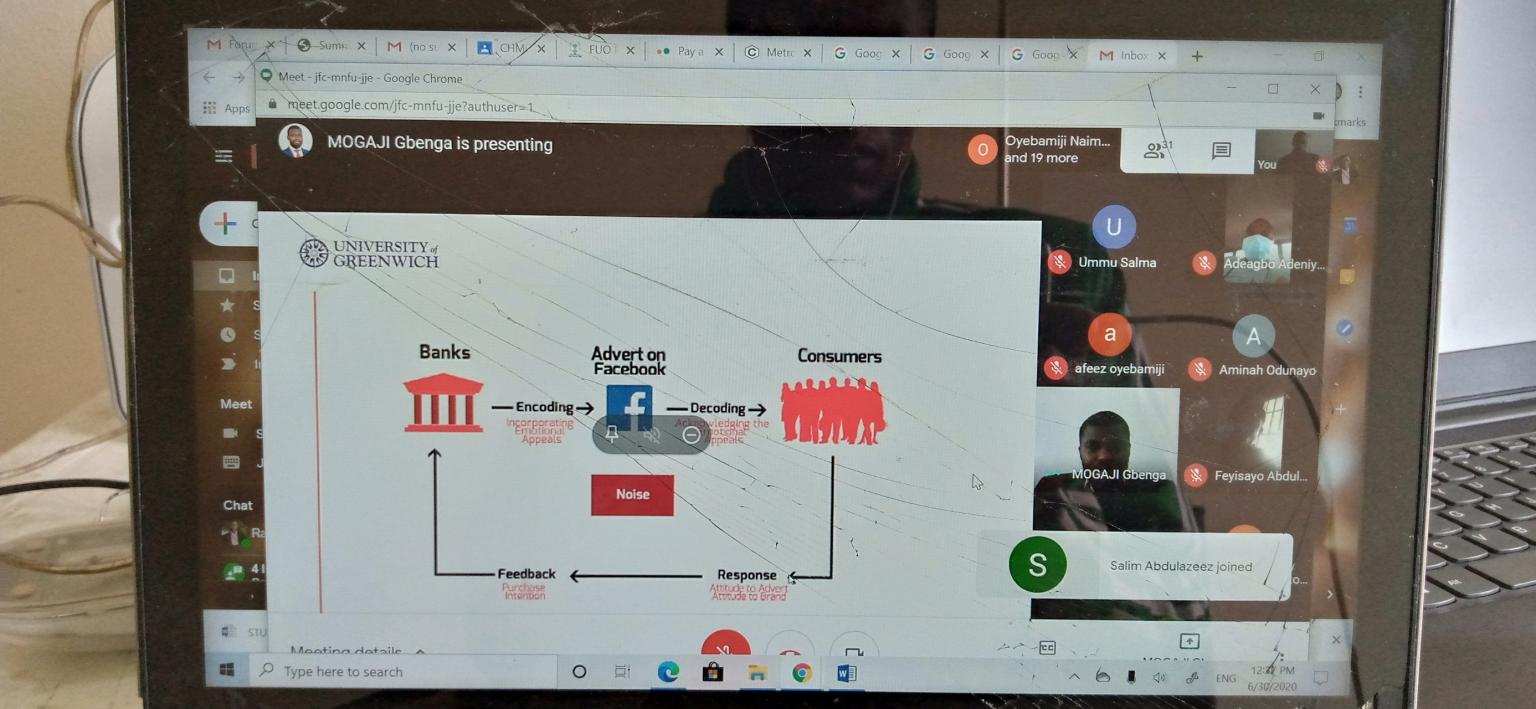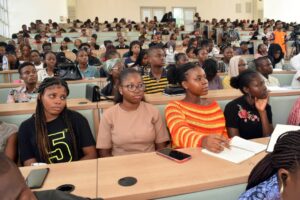Rasheed Adebiyi, Lecturer, Consultant in Strategic & Applied Communication and Researcher writes on his experience and challenges of remote teaching at the Department of Mass Communication, Fountain University, Osogbo, Osun State
The Coronavirus pandemic has come to disrupt the world we know as normal. Everyone has felt the sudden pause that the virus which originated from Wuhan has put on our lives. One of the major areas of the Nigerian national life affected greatly by the pandemic is education. This sector which has been shut barely two weeks after the index case was discovered in Nigeria is yet to be opened despite the eased lockdown. This has a lot of implications.
First, the demographics kept out of engagement to have a huge number to their advantage. They are many. Second, bubbling with a lot of energies, there is a tendency for them to be the devil’s workshop if their creative and physical energies are not productively engaged. Third, there are existing problems with their bracket, especially, for those in their adolescence and teenage years, even when the schools were on. There are fears of increasing drug addiction; rising sexual violence and a higher rate of depression which may all be due to lack of productive engagement.
So, when the Minister of Education, Mallam Adamu Adamu, directed Nigerian schools to start engaging Nigerian students of all levels in some kind of educational engagement through the virtual space, it raised a lot of hues and cries. While some criticized, citing cogent reasons, others praised heaving a sigh of relief that their children and teenagers who had been hitherto idle will have some form of learning engagement even if it is remote.
For people against virtual learning, there are important factors to consider. Which platform would be appropriate to abruptly engage students who are already used to face-to-face learning? How meaningful will such attempts be? Will a larger percentage of Nigerian students, who are from poor homes, be able to afford the resources to procure data for such learning exercise? Is it possible that the internet bandwidth as currently deployed in the country be good enough to support virtual learning? Who bears the cost of data? These fears are real! Yet, an idle hand could be a veritable tool in the hands of the devil. As a university teacher in a private university in Nigeria, I share my experience teaching remotely. I explore the opportunities, challenges and the way forward.
To teach and learn remotely has its own opportunities for both the teachers and their learners. Let us consider the students first. What does remote learning do for them? First, it keeps the students who are at home learning. They have their creative energies directed to a profitable venture. It keeps them busy and equally reduces wasted time as a result of the schools’ shutdown. I noticed this when my university’s management directed that we should go online to teach. The announcement of this “good” news on the students’ WhatsApp platforms received huge applause. They felt relieved from the boredom they were already getting used to. The enthusiasm was real. This links with the second opportunity- meeting the students in their own “domain”.
For the first time in their learning years, these students who are digital natives felt excited that they would be learning in the virtual environment using phones and devices they have always used for social interaction for learning. The eagerness to begin virtual learning was encouraging even for the lecturers. After all, only a poor teacher would not only be happy when their students show eagerness to learn. The third opportunity was the multimedia platforms to learn and teach. As against the brick and mortar teaching and learning systems both teachers and students were used to, an opportunity to deploy different platforms to explain and illustrate concepts arose. Videos, audio files, images and other online resources characterize digital learning and teaching. So, it was exciting getting engaged via these attention-grabbing platforms. It aids clarity and understanding of hitherto abstract concepts and ideas. For me, I grabbed the opportunity with both hands and deployed these materials to the fullest of my capacity. This also has some relationship with the third opportunity which digital learning and teaching presents.
Both students and teachers have the chance to co-teach, co-learn and share resources with interested partners across the world! I used this to a very large extent. In my advertising class alone, I brought two resource persons from both the industry and academia to co-facilitate with me. The learning platform, Google Meet, enabled virtual, live interactions in my class. The students loved it. Mr. Ayoola Gbade Bello, a Creative Industry expert and Dr. Emmanuel Mogaji, a marketing communication teacher, were brought into my class from Lagos and the United Kingdom respectively and at no cost at all! I was happy about it. My students were also very excited as well. Virtual learning gave us the expanded space to co-teach, co-learn and share resources! From my experience, remote teaching enabled us to explore learning resources online.
No doubt, virtual teaching and learning have its own opportunities, there are peculiarities that could make it an unpleasant experience for both learners and teachers. A conducive learning environment is one that education experts place emphasis on. A classroom context that is conducive to learning helps both the teachers and students to engage in mutually beneficial classroom experience. This may be lacking in remote teaching within a developing country situation. There are issues that frustrate seamless learning and teaching online. These include the stability of internet broadband, unstable power supply, appropriate and data-friendly learning platforms. These are part of the virtual learning infrastructure which must be in place before real learning could take place. These affected my classes to a large extent. For close to ten weeks of learning online, the week by week experience was not uniform. Sometimes you win some. At some other times, you lose some. It is painful and frustrating. Sometimes the network in my students’ areas would not be good. At some other time, there would not be power supply. All these affected seamless learning situations.
The problem of poor online learning infrastructure leads to the second challenge of remote teaching- poor attendance in the classes. Every university has an attendance rule. It is either you attend 60% of the classes in a course or you forfeit writing the examination. However, when as a lecturer, you understand that some students will not come to class either due to poor internet network or unstable power supply, what do you do? This is coupled with the fact these Millenials have a poor attitude to class attendance even in the physical classes. Sharing experiences with my lecturer from the UK showed that the problem is generational and intercontinental. For a lecturer to be successful in virtual teaching, they need much more than the teaching skills in the physical realm. This points to the third issue with virtual learning – more pressure on the lecturer in controlling the classroom.
Remote learning and teaching take much more from both the students and their lecturers than it is appreciable in the physical environment. To deliver maximally in a virtual environment, a teacher needs to prepare much more than they do for physical classes. You have to think of the best way to deliver. Is it through videos, audio or PowerPoint presentation? Or you just give a class note to the students? If that is not even the problem, then how do you keep your students in the classroom? How do you know if a student whose picture you are looking at on the screen is still there or has gone to do something else? How do you keep them from wandering off the virtual class? A lot of the times, you do not have any control over some things in the virtual realm. So, how do you control the students? These questions are what we will continue to deal with as we cope with the new normal of living and learning.
Despite the enormous opportunities and the frightening challenges that have accompanied teaching and learning in the virtual classroom, I am of the opinion that this has come to stay with us even after the COVID 19 curve has totally flattened. At worst, we have a bi-modal approach to learning and teaching. Nigerian universities need to be more creative in dealing with issues of connectivity and bandwidth. The Nigerian government should make it a policy for network providers to provide educational bandwidth for primary, post-primary and universities. This will solve the issue of network instability. Other issues could be resolved through constant training and appropriate feedback mechanism. The first step is to accept that this is not a 100-meter dash but a marathon.




Mfon
This is awesome . such a long and meaningful post. Thank you for sharing.
KIchime Gotau
Great Efforts Sir.
I am a development Journalist (Diploma Mass Communication & Bachelor’s in Political Science), I find your cutting – edge module novel and appropriate and will love to partner with you in sundry ways; from communication for development to Advertising(Radio, TV, Social Media & Prints) Messages and Media productions & Measurements etc.
Kudos Dear Sir.